Dart frogs make fascinating pets. Not only are they beautiful, but they’re also quite interesting to watch. If you’re thinking of adding a dart frog to your collection, you may be wondering how many you can keep together.
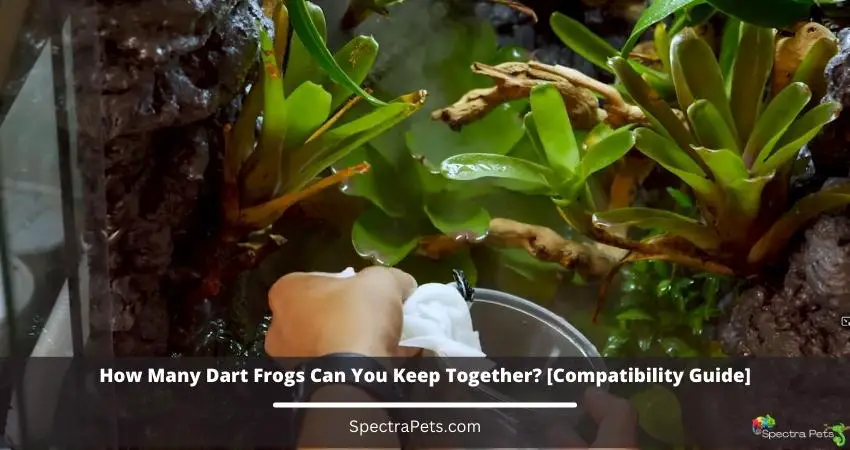
If your tank is big enough, you can keep them in groups of 2 to 5. It’s important to provide plenty of space for them to roam, so a tank that’s at least 10-15 gallons in size is recommended for 2 frogs.
If you’re keeping more than one frog, make sure they’re of a similar size so they don’t bully each other. Also you need to avoid mixing species (I will explain it later in this article).
So, keep reading to see all the nitty-gritty of keeping these amazing frogs in groups.
How many dart frogs can you keep in a tank?
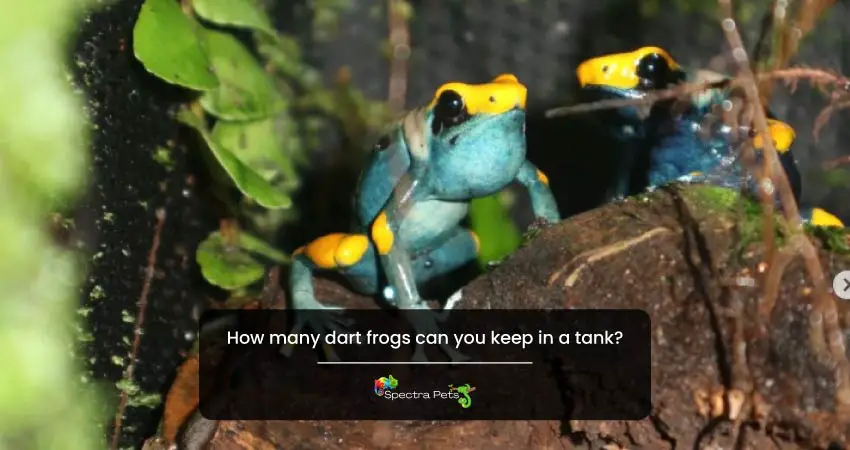
Image Credit: Instagram, dendrobates_out
As a general guideline, an adult dart frog needs a 5-10 gallon tank to live happily. That means if you think to keep them together, make sure each one of the frogs gets an average 5-gallon space inside the tank.
Having the right calculation is essential to ensure you don’t make a mistake regarding the size of the tank. Then again you also need to consider the size of the dart frog as different dart frog species have different growth.
If you have a plan to keep 3-4 dart frogs, then go for a gigantic size vivarium that provides enough space for each frog.
For example, a 75-gallon vivarium or even a bigger size tank will ensure that your frogs will have a large space where they can live comfortably without confronting each other.
However, in the juvenile stage of dart frog, you can keep 15-20 inside one massive tank.
Which dart frogs can live together?
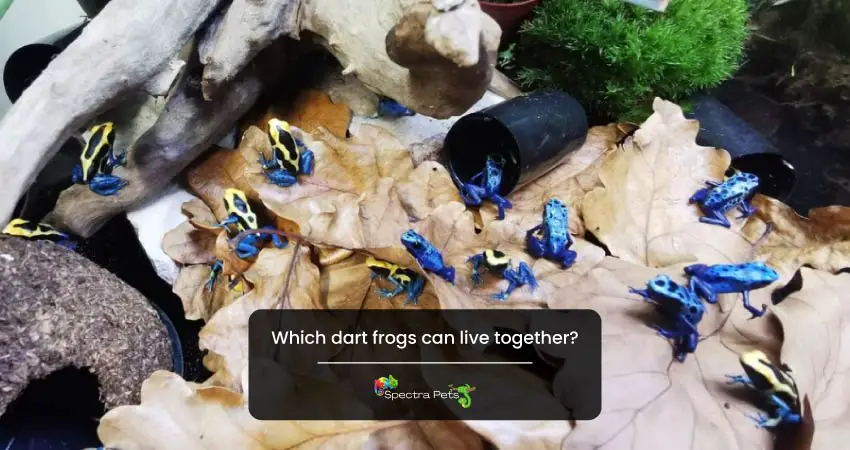
Image Credit: Instagram, dart__frog
Despite the huge variety of dart frogs, the choice becomes extremely limited when you want to keep them together.
However, a very big size tank would always be best for multiple frogs.
Green and Black Poison Dart Frog ( Dendrobates auratus)
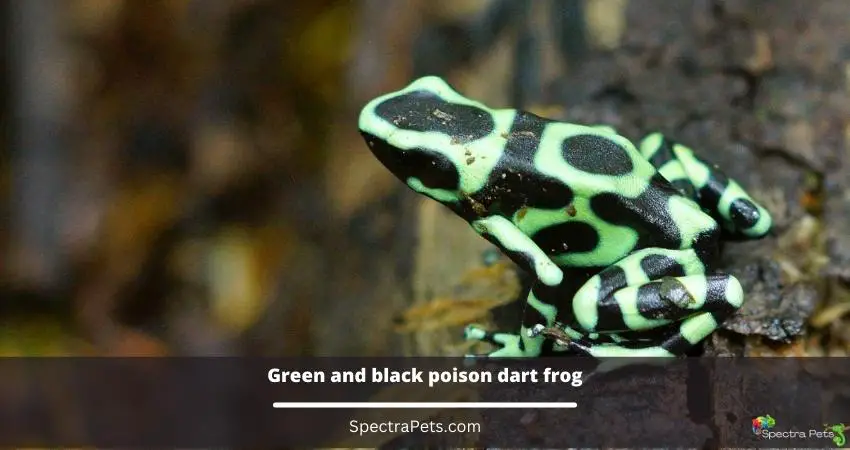
This species of dart frog is excellent for beginners. Due to their lack of aggression and easy care plus breed, this type of frog can be kept inside the terrarium without much headache.
Inside a 10-15 gallon tank, you can keep 1-2 green and black poison dart frogs. It would be best if you kept it. These species are not ultimate climbers, so you can use tanks that have good width and low height glass.
Golden poison dart frog
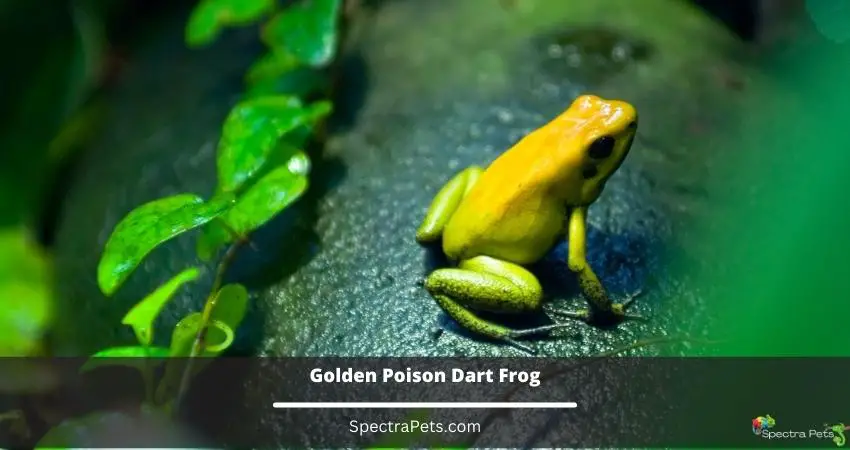
This venomous dart frog can live in groups in a terrarium although back in the wild they have a solitary lifestyle.
You can keep 1-2 Phyllobates terribilis inside one single tank. However, the tank size has to be at least 20–25 gallons. Though they can live with the same species, do not dare to keep them with other species. The result can be fatal.
Epipedobates Tricolor
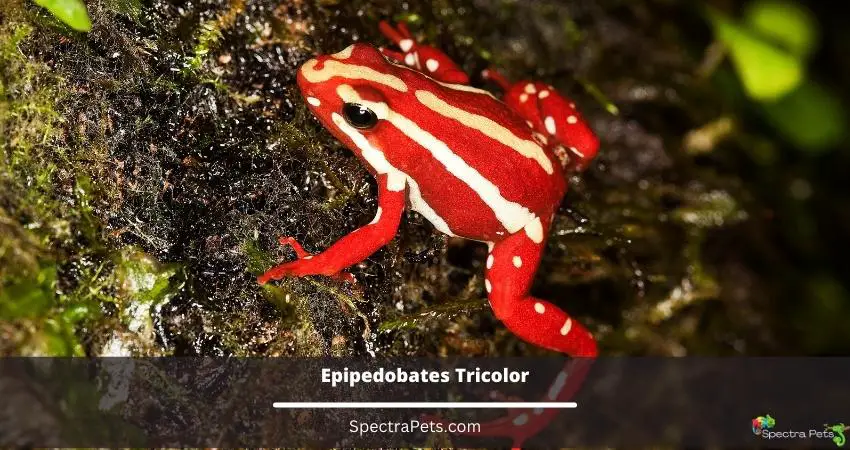
These Peru and Ecuador native frogs can do pretty well when you put them in groups. Luckily you can keep several males and females in one house.
It would be best if you kept more female Epipedobates Tricolor to ensure the balance and the chance of fighting over females to a minimum.
For 3-4, Epipedobates Tricolor can happily live inside a terrarium size of 60x50x50’’.
Splashback poison dart frog ( Adelphobates galactonotus)
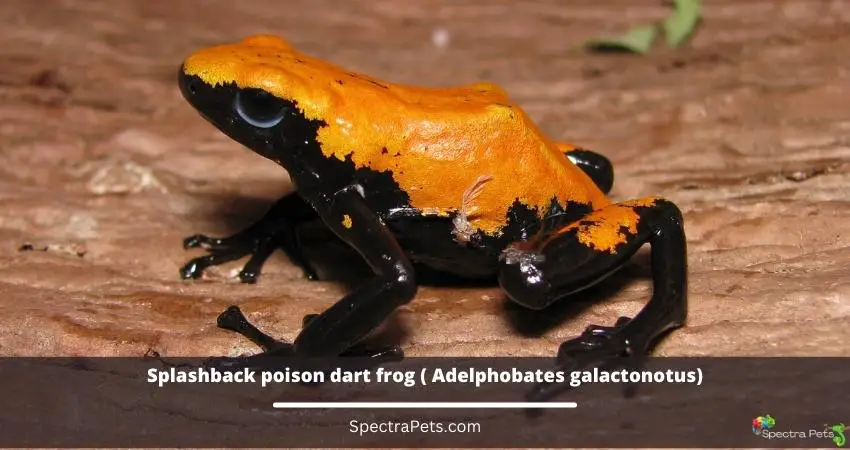
Due to their explored nature and territorial behavior, you have to keep them inside a big size tank that has at least an 80x50x50’’ size or at least a 45-gallon tank. Inside this size terrarium, 3 female frogs can happily live with 2 male frogs.
The splashback poison dart frog loves to climb. So adding enough climbing materials to their enclosure would make them feel like being in their natural habitat.
Phyllobates bicolor with Oophaga histrionica
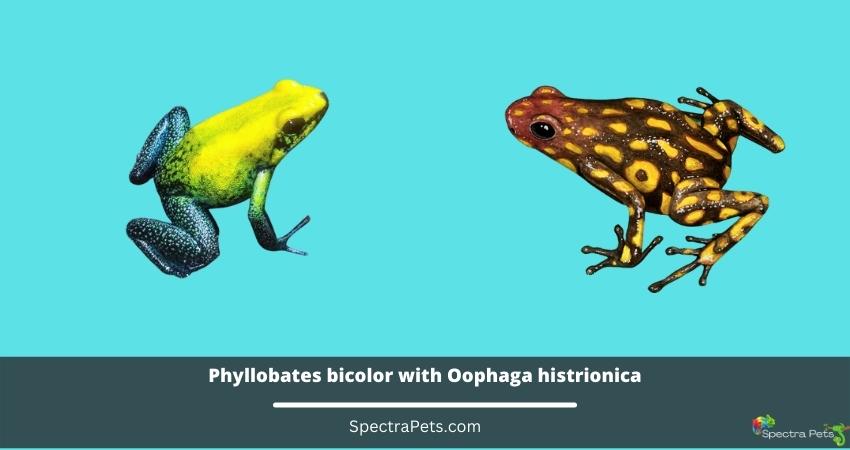
The good thing about both of the species is that these dart frogs live in the same area as a neighbor. This indicates they often encounter each other and without hassle, they can live together maintaining their safe distance.
Inside a 60x50x60 size tank, you can keep 3 Phyllobates bicolor. among them should be 1 male & 2 female. And for Oopahaga, you can keep a male and a female.
If you evenly design & properly place the hiding place inside the terrarium, they will have a good time. On top of that, their preferred temperature & humidity level is identical, so it’s a big advantage for you as the owner.
Dyeing poison dart frog ( Dendrobates tinctorius )
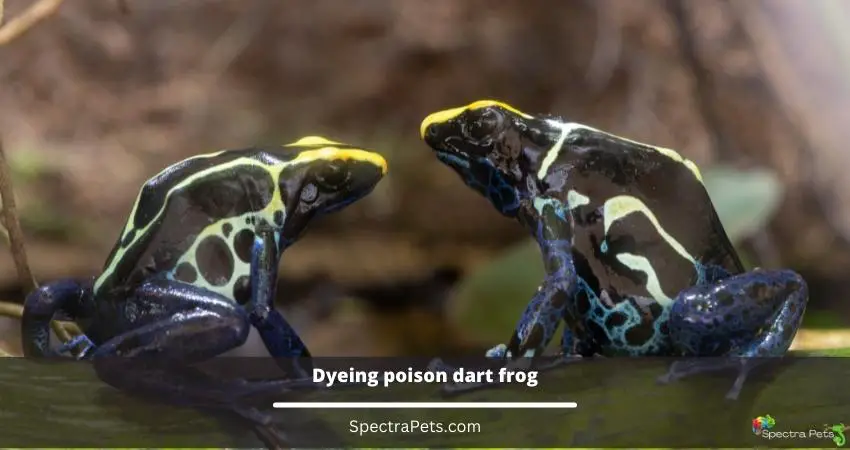
Due to their mixing nature with other frogs, you should not keep the dyeing poison dart frog with other species. Rather keep Dendrobates tinctorius with the same species.
Though these species do excellently when being in a group, there’s a twist. In their juvenile period, they are absolutely okay with each other. But, when they become adults, the females would be extremely aggressive with each other, especially when the mating season knocks at their doors.
So the basic rule is you can keep 1–3 frogs inside one terrarium when they are young. As soon as they become adults, simply relocate the female frogs to different enclosures. However, you can keep the female with one male.
Bumblebee Poison Dart Frog ( Dendrobates leucomelas)
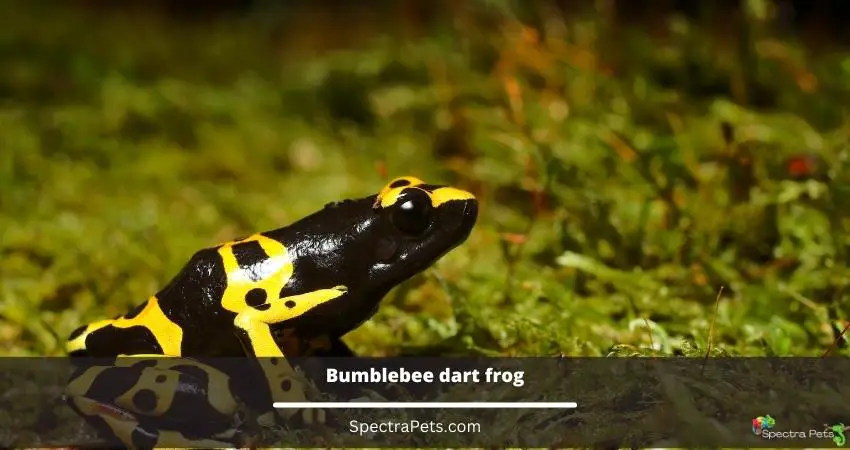
These amazing creatures are also known as yellow-headed dart frogs. From A to Z, these frogs have a powerful character. When it comes to territory these frogs turn violent, so a lot of care from the owner is highly recommended.
However, in the big group, they can get quite active and go well; but for that, you need to provide a lot of hiding places. If anything goes wrong, they can avoid each other and take safe shelter. This species is one of the loudest of all frogs.
So, you can keep 3 bumblebee poison dart frogs in one enclosure size 18x18x18’’. 2 females and 1 male would be the best gender ratio for smooth breeding.
Yellow striped poison dart frog (Dendrobates truncatus)
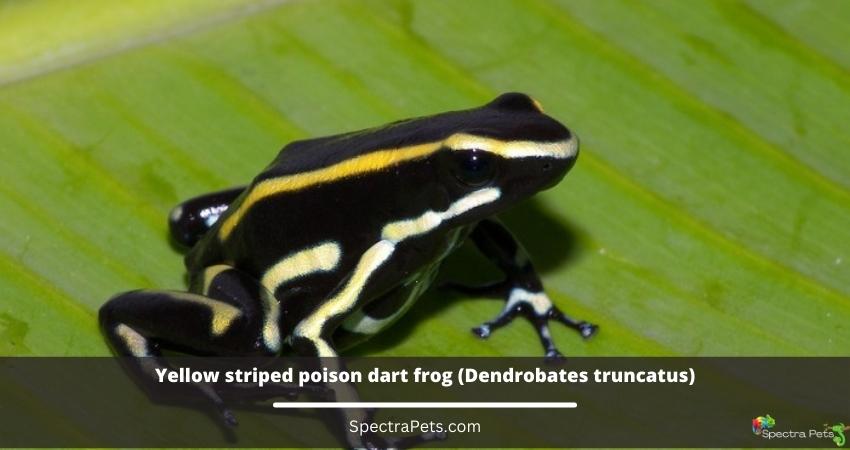
Due to their gentle nature, you can keep them in the group without much hassle. Four yellow striped poison dart frogs can be housed in a 15-gallon tank.
2 male & 1 female dendrobates truncatus can live in peace. These frogs are very good for people who are going to pet frogs for the first time.
Tips to Keep Dart Frogs in Groups
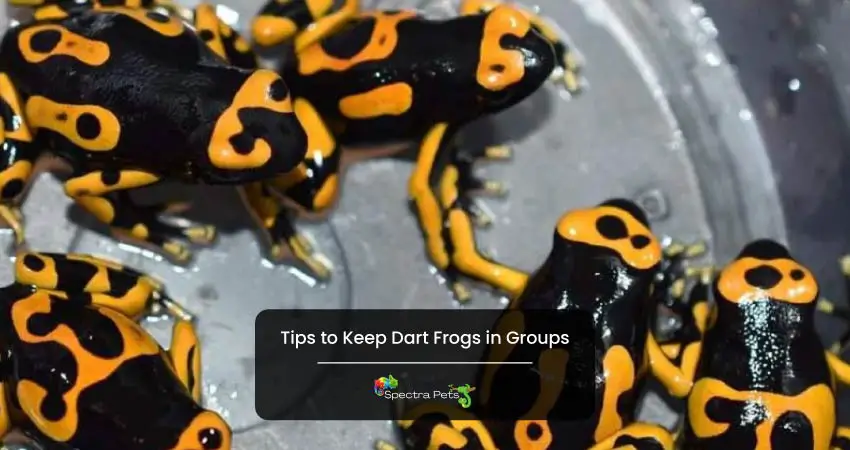
Image Credit: Instagram, dart__frogs__122
There are many reasons why you might want to keep dart frogs in groups. Perhaps you find their vibrant colors and interesting patterns aesthetically pleasing, or maybe you’re interested in observing their complex social interactions.
Whatever your reason, there are a few things you need to keep in mind if you want to successfully keep dart frogs in groups.
1. Provide Plenty of Visual Barriers
Frogs are highly visual creatures, so it’s important to provide them with plenty of visual barriers. Try using plants, rocks, or even small pieces of cardboard to create a maze-like environment for your frogs. This will not only give them something to look at, but it will also give them a sense of security as they’ll be able to hide from each other if they need to.
2. Adequate Feeding
One of the most important things you need to do when keeping dart frogs in groups is to make sure they’re adequately fed.
These frogs are notoriously picky eaters, so you’ll need to research what kind of food they like and make sure to provide them with enough of it.
It’s also important to note that male and female frogs have different dietary needs, so you’ll need to adjust your feeding program accordingly.
3. Raise Frogs Together
If at all possible, try to raise your frogs together from a young age. This will help them develop strong bonds with each other and make it more likely that they’ll stay together once they reach adulthood. Of course, this isn’t always possible, but it’s something to keep in mind if you’re looking for ways to keep your frogs together.
4. Watch Out for the Sex Ratios
Another thing to keep in mind when keeping dart frogs in groups is the sex ratio. Ideally, you should have two males for every female frog as this will help prevent territorial disputes between the males.
However, if you can’t find enough males or if you end up with too many males, don’t worry – just introduce some additional visual barriers into the enclosure and everything should be fine.
5. Coloration
Coloration is also something to take into account when choosing cohabitating dart frogs. Some species of frog are brightly colored as a way to warn predators of their toxicity, while other species are more muted in coloration.
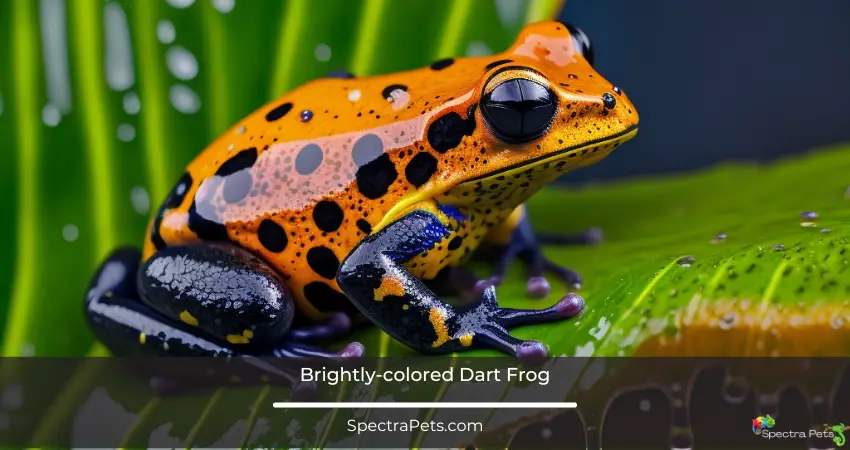
If you put a brightly-colored frog and a more subdued-colored frog together in the same tank, the brightly-colored frog may view the other frog as competition and become aggressive. For this reason, it’s generally best to choose frogs with similar coloration patterns.
6. Observe and Act
Finally, the most important thing you can do when keeping dart frogs in groups is simply to observe them and act accordingly. Every frog is different, so there’s no one-size-fits-all solution for keeping them happy and healthy.
By paying attention to your frog’s behavior and acting accordingly, you’ll be able to figure out what works best for your particular group of frogs.
Though your frogs are living together for years, all of a sudden they can react to each other aggressively and harm each other due to territory. So close monitoring of the poison dart frog is a must.
7. The aggression of the species
Finally, you’ll want to consider temperament when selecting dart frogs for your tank. Some species are more laid back and easygoing while others are more high-strung and prone to aggression. It’s generally best to err on the side of caution and choose frogs with similar temperaments so that they don’t stress each other out or get into fights.
Keeping dart frogs in groups can be a rewarding experience, but it’s important to remember that these creatures have unique needs that must be met if you want them to thrive.
Did you know that there are over 100 different species of dart frogs? And that housing different species together in the same vivarium is discouraged? Let’s explore why is it so…
1. Losing original morph
The first reason is, that some dart frog species are close to each other in attributes. You can easily breed a Dendrobates auratus, Dendrobates leucomelas, and Dendrobates tinctorius and there would be beautiful offspring.
But when you plan to breed a Dendrobates auratus with Ranitomeya Sirensis Biolat, Ameerega Bassleri Black, Adelphobates Galactonotus Moonshine or Phyllobates terribilis ‘Yellow’ they will produce offspring which are known as crossbreeding.
But the problem is the newborn would be sterile so the original genotype and phenotype would be lost. This is a big downside of keeping different species.
2. Disease spreading
Another primary reason why different species of dart frogs should not be housed together is that they can easily transmit diseases to one another.
Even if one species is not naturally susceptible to a certain disease, it can still act as a carrier and spread it to other species.
This is particularly true of chytrid fungus, which has been responsible for the decline of many amphibian populations around the world.
3. Diet variations
The next reason why it’s not a good idea to house different species of dart frogs together is that they often have very different dietary needs.
For example, some species are fruit eaters while others are carnivores. This can make it difficult to provide all of the necessary nutrients for all frogs if they’re housed together.
4. The suitable temperature and humidity are a bit different
Lastly, different species of dart frogs often have different temperature and humidity requirements. This means that housing them together can lead to suboptimal conditions for all involved.
In order to ensure that your dart frogs are healthy and happy, it’s best to house them separately according to their specific needs.
You may find it interesting: Can dart frogs live with tree frogs?
Final Words
Keeping dart frogs in groups can be a rewarding experience, but it’s important to remember that these creatures have unique needs that must be met if you want them to thrive.
Hope this short article gave you a well-enough idea of how many dart frogs can you keep together in one tank.

